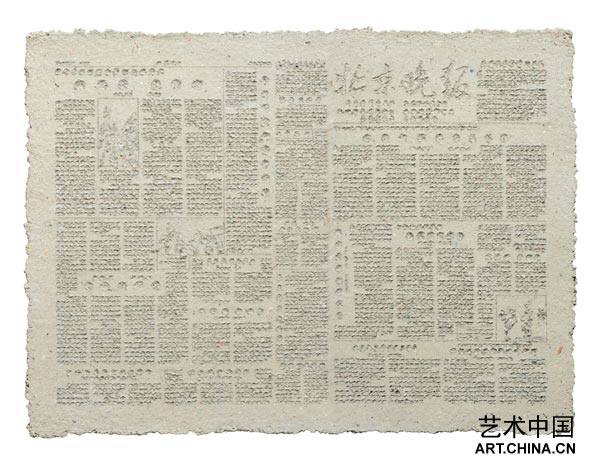
展覽:無語
參展藝術家:蔡志松,施勇,薛松,張震宇
策展人:傑瑞米
展覽時間:2009年3月20號至5月1號
地點:仁藝術中心
開放時間:每天上午11時至下午6時
網址:www.yanclub.com
電子郵件:gallery@yanclub.com
近些年,媒體之軀迅速膨脹。越來越多來自媒體的廣告、觀點、出版物和商業言論等大量資訊簇擁前來,充斥並淤積於人們的日常生活。漸漸,“資訊”已非反應、理解現象的關鍵所在,而是被畸化為一支日益氾濫的濁流,眾多事件無所謂輕重地交織其中,令人困惑和無從辨讀。
面對這股濁流,我們抑或沉默無言。但作為藝術實踐的一個重要組成部分,藝術家會運用清除、簡化和整合等手段重構一個現實表像之下的真實。Robert Raushenberg曾消抹De Kooning的繪畫以尋求一種極少主義(作為一種現代藝術流派,極少主義出現並流行于20世紀50--60年代,主要表現于繪畫領域。極少主義主張把繪畫語言削減至僅僅是色與形的關係,主張用極少的色彩和極少的形象去簡化畫面,摒棄一切干擾主體的不必要的東西。)的歸宿,其作品隨著消抹的工時被“削減”,最終呈現出的主體接近於事實的本真狀態。這種思維一直存在於藝術之中。
莊子的觀點給了我們更多關於這種思維必要性的中國式啟示。他指出了語言的矛盾性——語言可以去塑造事物,但無力於全部事物的再現,而只能辨證性地反映出事物的部分。
藝術家們通過其作品的“空白”展現了他們所做的思考。事物表像消逝的同時,主體隱隱浮現,這就為觀眾的個體詮釋打開一扇門和一條通往更深層思考的通道,也是一種對無所謂在場的空洞的語言之存在意義的反詰。
如莊子云:“言者所以在意,得意而忘”。藝術家正是在展露一種超越語言或者説表像的創作源點。
張震宇,來自湖南。他運用特殊方法將報紙或書籍轉變為紙漿,然後將紙漿重塑于畫布。通過重塑剝離先前各種表徵使之呈現出最初的單一物質屬性。報紙仍是報紙,但被消除了時效性,書籍成了只剩實體和形狀的無言書。藝術家持續一年的時間,每天細緻地刮擦掉人民日報首頁的文字和圖像資訊。
薛松,來自安徽。他將各種紙上出版物以燃燒的方式進行“消解”,使原本富含“意義”的話語載體變成殘片和灰燼,藝術家以此作為繪畫材料使作品包含多種衝突與消解。
施勇的VIDEO作品以自己家裏的書櫃照片為創作基點,敘述了自己多年的閱讀及個人體驗。畫面裏的標題和顏色隨著時間的流逝慢慢褪去,最後只剩下黑白色調的客觀物象,令每位觀者對其心生關聯並産生思考。
蔡志松的雕塑基於對中國傳統事物的介質以及形態的轉換,通過這種轉換重新解讀其精神內在。比如用鉛金屬塑成傳統的宣紙軸,雕塑本身的厚重感改變了我們對傳統事物的記憶形態。

Exhibition: Beyond Words -
Participating Artists: Cai Zhisong, Shi Yong, Xue Song, Zhang Zhen Yu.
Curator Jeremie Thircuir
Exhibition Dates: March 20th – May 1st 2009
Location: Yan club Arts Center
Opening hours: Open everyday from 11am to 6pm
Website: www.yanclub.com
Email: gallery@yanclub.com
The recent decades saw a multiplication of discourses and media relating them, more publications, more opinions from a more and more decentralized media sphere, more advertisement and commercial discourses.... Information is not anymore a key of understanding and reflection but became a confused flux of unhierarchized facts that one can hardly filter and decode.
Facing and maybe sinking in front of this logorrhea of contents, artists need to erase, to simplify, and unify these discourses as an important part of their practice. From Robert Raushenberg erasing De Kooning’s drawing to the labor of time slowly erasing artifacts from the past, erasing has always been present in art.
The necessity of this erasing can be enlighten in a more Chinese perspective by the words of Zhuangzi pointing out contradictions that the language can create and the incapacity of the language to represent a global reality but only partial and contradictory truths.
From the void of their artworks, their thought can start to express. From the disappearing obvious the New can reveal himself, subjects can start to appear giving the audience an open door to their own interpretation and understanding, a way to go further, a revelation of the meaning from sterile appearances of a vacuous language.
As In Zhaungzi “Words exists because of meaning; once you’ve got the meaning you can forget the words.”. The artists exhibited are now working beyond the words, beyond the obvious.
言者所 以在意,得意而忘
Zhang Zhenyu is an Artist from Hunan. His unique technique employs newspaper or books that he turns into a paste. He applies this paste on the canvas and then carves it to reshape it to look like its original material empty of all these previous characteristics. The newspaper is still a newspaper but its temporality is gone. The books are void from words but just the material and the shape remains. In “renminribao”, for one year the artists has been meticulously erasing the content of the first page of the main Chinese newspaper.
Xue Song is from Anhui, his collage art works uses fire and newspaper whose significancy is erased. He will turn hundreds of meaningful information selected from various publications into a more simple artwork. The artists is using the elements to take-over the profusion of meaning.
Shi Yong video starts from a photograph of his home’s bookcase. Compilation of years of reading and personal experiences, within the time of the video, the titles as well as the colors will slowly be erased by the artist, turning the artist personal bookcase into a back and white impersonal/universal photograph where everyone can relate with.
Cai Zhisong’s sculptures are based on a distortion of the medium. His sculptures will reinterpret Chinese artifacts by modifying the material and playing with its density. The traditional rice paper scroll is now made out of lead. The heaviness of the sculpture making us change our perception of our memories through the object.